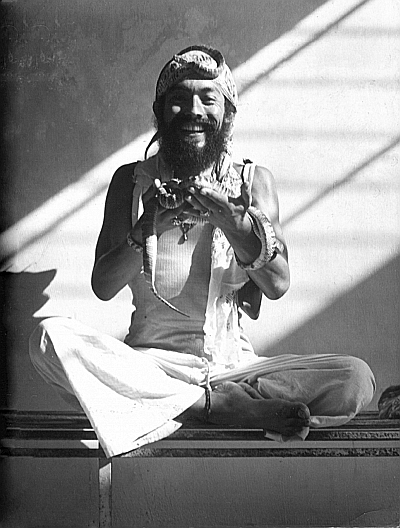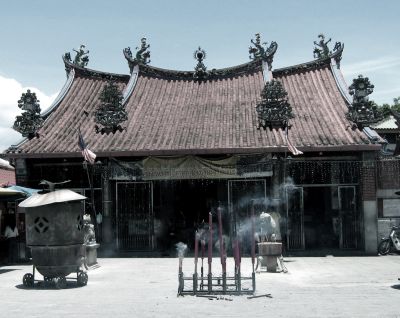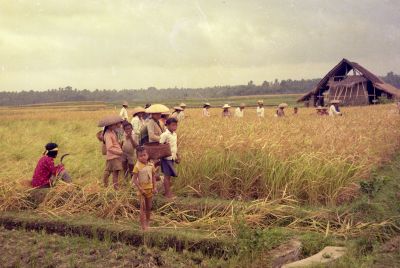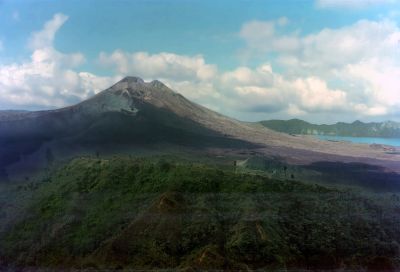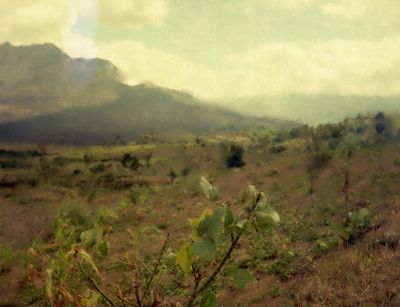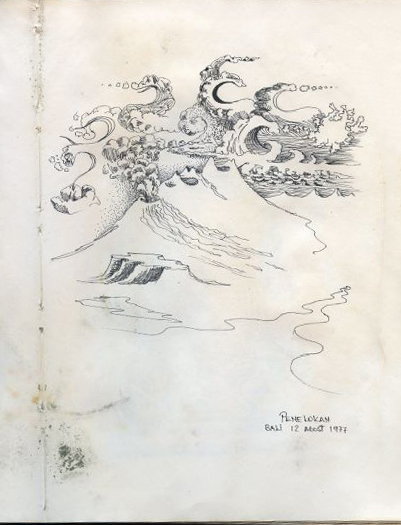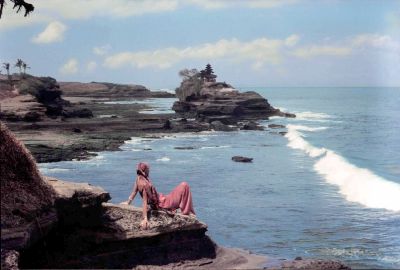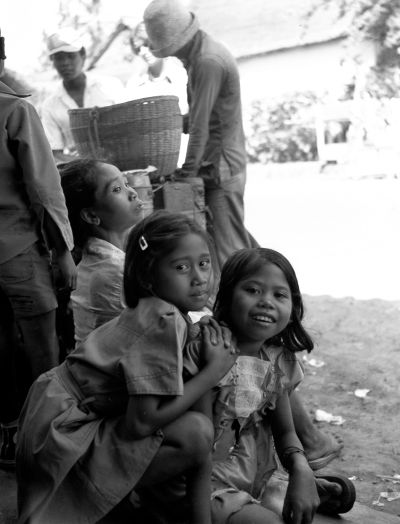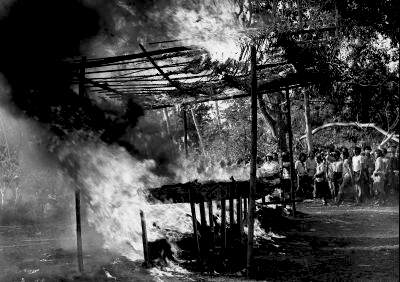We stay in Bali three months.
Each country we visited we try to stay the three months visa or more.
And now we wanted to go back to Kathmandu.
We was very fascinated by Kathmandu.
So, we have flown directly to Kathmandu (and stay another period of time) before we go back to Frankfurt, Germany.

Island of Gods
BALI

In the Land of Magic
Please, click the image to Zoom
We've flown from Kathmandu to Bangkok, Thailand.
We could not cross by land through Bangladesh and Burma (Myanmar) because of geographic, political and atmospheric conditions.
This was our first flight on our Hippie Trail trip. We didn´t have other choice than to take the chance.
From Bangkok we took a train to Malaysia, and then, to Penang Island.
In the border of Thailand/Malaysia, the authorities give us this notice:
After this immigration warning I was asking to myself how can they allow me to cross the border to Malaysia, when I was looking exactly the person they were questioning: The Last Hippie.
By the end of 1977, I was looking like this
(I didn´t saw myself in the mirror for quite a long while).
So, what happen was that the last hippie had entered a prohibited zone.
I had transgressed the holy sanctuary of neoconservatives corporate capitalists.
Singapore and Malaysia were very prosperous nations and they preferred to welcome Yuppies, rather than Hippies.
Allowing me to enter to Malaysia was a very risky gesture since they were putting in danger their national security and their national interest.
My presence here could trigger much confusion and despair.
Maybe we were not "bona fide" tourist, but, for sure we were not Hippies either. We were artists of the counterculture revolution travelling the world.
Gisela and me, by now we were traveling almost two years visiting different nations, cultures, people, religious and absorbing all cultural diversity.
At this point we were above good and evil and we were integral to life on Earth. We become global but with local indigenous life interest, so, we were world citizens exercising our freedom, here and now, mixing with natives wonderful human beings.
The Snake Temple of Penang
The temple is filled with the smoke of burning incense and a variety of pit vipers. The vipers are believed to be rendered harmless by the sacred smoke, but as a safety precaution, the snakes have been de-venomed, but still have their fangs intact.
The temple was constructed in the 1805 to honour Chor Soo Kong (also known as Qingshui), a Buddhist monk who lived during the Song dynasty (960–1279) for his numerous good deeds especially in healing the sick and giving shelter to snakes
Chinese musical instruments as Guzhen, xiao, dizi, etc.
PENANG ISLAND
Penang Island is a Malaysian state located on the northwest coast of Peninsular Malaysia, by the Malacca Strait. It has two parts: Penang Island, where the capital city, George Town, is located, and Seberang Perai on the Malay Peninsula.
Penang's modern history began in 1786, upon the establishment of George Town by Francis Light. Penang formed part of the Straits Settlements in 1826, which became a British crown colony in 1867. Direct British rule was only briefly interrupted during World War II, when Japan occupied Penang; the British retook Penang in 1945. Penang was later merged with the Federation of Malaya (now Malaysia), which gained independence from the British in 1957 Known as the Silicon Valley of the East for its industries, Penang is one of Malaysia's most vital economic powerhouses.
The Kuan-YinTemple in Penang
The Kuan Yin Teng (The Goddess of Mercy Temple) is a oldest Taoist temples in Georgetown built in 1800.
During Chinese New year a lot devotee are pray at Kuan Yin Teng temple.
Writing and reading in our room in the Hotel of old Penang.
Vicente writting his diary
BALI
Being just 8 degrees south of the equator, Bali has a fairly even climate all year round. Average year-round temperature stands at around 30 °C (86 °F) with a humidity level of about 85%.
In 1597, the Dutch explorer Cornelis de Houtman arrived at Bali, and the Dutch East India Company was established in 1602. The Dutch government expanded its control across the Indonesian archipelago during the second half of the 19th century (see Dutch East Indies).
Dutch political and economic control over Bali began in the 1840s on the island's north coast, when the Dutch pitted various competing Balinese realms against each other.
In the late 1890s, struggles between Balinese kingdoms in the island's south were exploited by the Dutch to increase their control.
Taking some rays of sun while writting my diary.
Mount Agung
Mount Agung or Gunung Agung, is a currently active volcano in Bali, that occasionally emits smoke and ash. Mount Agung is the highest point in Bali. It dominates the surrounding area, influencing the climate, especially rainfall patterns.
The eruption of 1963 was one of the largest and most devastating eruptions in Indonesia's history.
On February 24, lava began flowing down the northern slope of the mountain, eventually traveling 7 km in the next 20 days.
On March 17, the volcano erupted (VEI 5), sending debris 8 to 10 km into the air and generating massive pyroclastic flows.
These flows devastated numerous villages, killing an estimated 1,100–1,500 people.
Cold lahars caused by heavy rainfall after the eruption killed an additional 200.
A second eruption on May 16 led to pyroclastic flows that killed another 200 inhabitants.
Subak irrigation system in the rice fields
Subak is the water management (irrigation) system for paddy fields on Bali island, Indonesia
which was developed in the 9th century. For the Balinese, irrigation is not simply providing water for the plant's roots,
but water is used to construct a complex artificial ecosystem. The system consists of five terraced
rice fields and water temples covering nearly 20,000 hectares (49,000 acres).
Some litle wells of water formed around Tanah Lot.
Gisela in touch with her favorite element: water.
Entrepenours for fun in the Flea Market of Legian Beach
Exclusive jewelry designed by ourselves in Kathmandu to be sold in the flea market of Bali.
The precious stones were from India and Kathmandu.
A procession of balines women to offer flowers and food
to the Gods in the Hindu temples of the village.
In the environment rules the smell of fragrant frangipani flower. The local people are deeply spiritual.
It is the land of 10,000 temples, and this gives some indication of the importance that spirituality has played in the island’s history, and how it continues to play a key role today.
Balinese Hindu festival. Here, the event is the full moon ceremony and offerings are brought to the local temple as a sacrifice to the Gods. The offerings are made up of flowers, food, money, palm and banana leaves, and incense.
Ngaben, A cremation ceremony
Ngaben is the Balinese word that local people use when referring to their cremation ceremony – it can be translated as meaning, “turning into ash”. This is the ritual they follow when ushering the person into their next life or sending them on to Moksha. Unlike funeral services in other parts of the world, in Bali it is a time to celebrate. Tourists should not be surprised to hear local people talk about how much fun they had at one of these occasions, and if foreign visitors are lucky enough to attend one they will see for themselves that it is far from a somber occasion. The goal of those attending the ceremony is to help the dying person cut any ties they have to their old life, so that they will feel happy to move on.
The Balinese view the cremation of a loved one as a time of celebration, and this is one reason why the Ngaben ceremony is so remarkable to outsiders. The local people are usually willing to allow respectful foreign guests to experience this unique way of sending off the deceased to the next life. One of the surprising things is that the person who is being cremated may have already been dead for years, but it is only now that the family can afford the cremation ceremony.
The Balinese view death as being part of a continuous cycle that involves birth, life, and death. This cycle continues until the person’s soul is purified. When this point of complete purification is reached, the individual can then be united with God. The local people believe that the person who has just died will soon be reborn as somebody else, and all newborn children are thus seen as reincarnated souls. In order for the dead person to be able to reincarnate they must first be released, and the Balinese Cremation Ceremony is what makes this happen. If the dead person lived a particularly good life, they may even skip reincarnation altogether to enter a state known as Moksha where they will finally be free of the cycle of life and death.
(Drawing from my diary)
A popular Balinese Barong and Kris dance drama performance.
The dancer is possessed by the magic power of God Rangda.
Melasti ceremony
A hindu ritual at sea to appease and please the Gods and demons spirits hanging around.
The Melasti ceremonies are the blessings for the external, the symbols of ancestors, of good and evil, they at the same time purify the self.
The blessed items are symbols of the cosmos, the universe, Bhuwana Agung (the larger world), whilst we humans are Bhuwana Alit (the little world).
Gisela loved the sea, the jungle, the mountain, the deserts, etc. She loved the world and the diversity of cultures, life and humanity. Planet Earth was her paradisiacal home.
THE END






